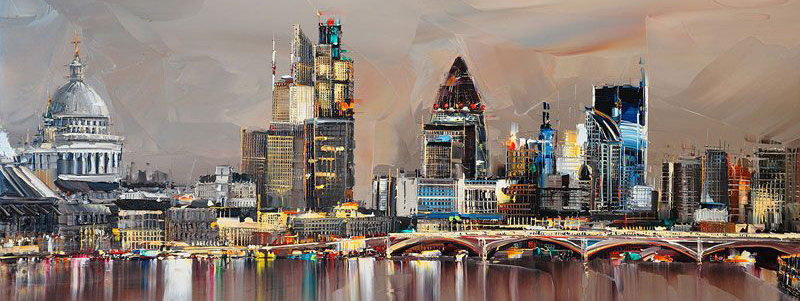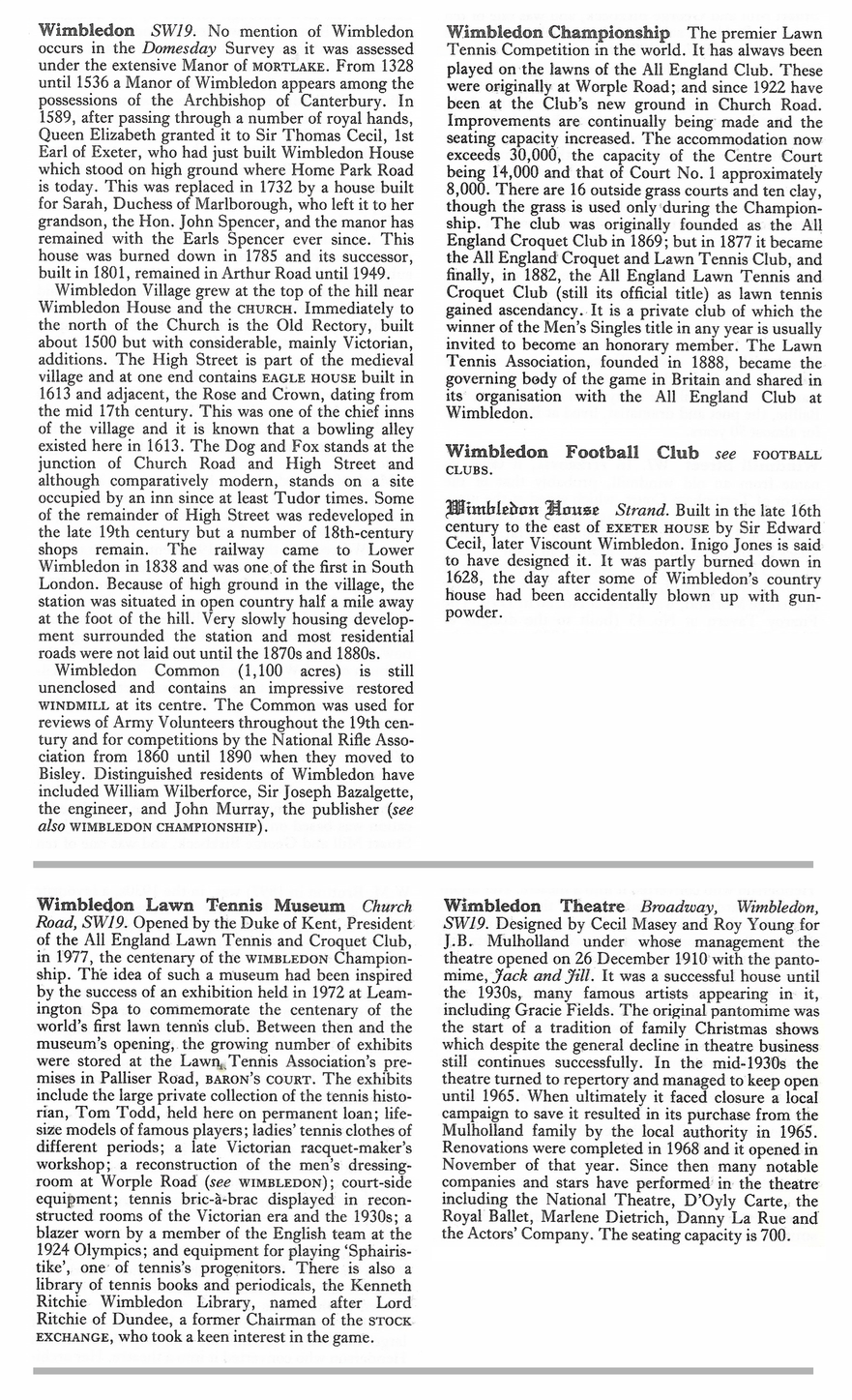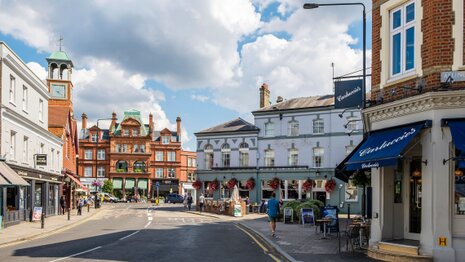 Wimbledon, known worldwide for tennis matches and the football stadium, is located in southwest London and is a pleasant blend of ancient and modern. The transcription of the name has undergone various changes before settling on the current one. The area was already inhabited in the Iron Age, or rather, the hilltop was. A fort had been built there, now known as Caesar's Camp, although it has pre-Roman origins. The fort was circular, and the fortifications covered an area of several acres.
Wimbledon, known worldwide for tennis matches and the football stadium, is located in southwest London and is a pleasant blend of ancient and modern. The transcription of the name has undergone various changes before settling on the current one. The area was already inhabited in the Iron Age, or rather, the hilltop was. A fort had been built there, now known as Caesar's Camp, although it has pre-Roman origins. The fort was circular, and the fortifications covered an area of several acres.Near Caesar's Camp was a well, built over a spring, that supplied water to the occupants of the camp. Over the centuries, Wimbledon gained increasing importance, with kings and aristocrats coming to live here. The village continued to expand and had many visitors, thanks also to the transport service established in the 18th century by the still-existing Dog and Fox pub, the oldest establishment in the area. Along the road, however, there was a risk of being attacked by highwaymen such as the likes of Jerry Abershawe. Daniel Defoe wrote that Londoners came here seeking an "escape from the hurries of business to draw their breath in clear air and to divert themselves and their families in the hot weather."
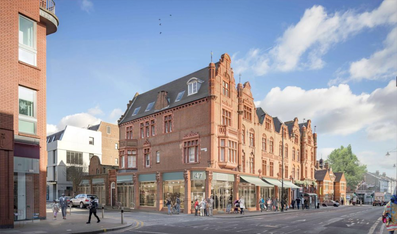 Wimbledon Hill Road, which descends from the village to the station, was once simply called "road to Merton." In 1943, some local councillors had proposed naming it Stalin Avenue, in recognition of "our brave Soviet ally." At the foot of the hill, between 1908 and 1938, there was always a reinforcement horse stationed, indifferently named Jack, even though the animal in question would change, and was to help draft horses struggling to pull vehicles up the hill.
Wimbledon Hill Road, which descends from the village to the station, was once simply called "road to Merton." In 1943, some local councillors had proposed naming it Stalin Avenue, in recognition of "our brave Soviet ally." At the foot of the hill, between 1908 and 1938, there was always a reinforcement horse stationed, indifferently named Jack, even though the animal in question would change, and was to help draft horses struggling to pull vehicles up the hill.The beautiful St Mary's church, which incorporates parts of its predecessors, is from 1843 and was designed by George Gilbert Scott. At its eastern end stands the mausoleum of engineer Bazalgette, who built the Embankment and London's sewers. The stained glass windows are by William Morris.
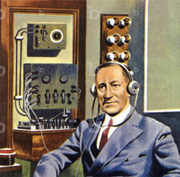 Guglielmo Marconi at The Gothic Lodge - The Gothic Lodge, built in 1761 with its charming pointed windows, was the first house in London to have electric light. Guglielmo Marconi tested his wireless telegraph here, sending messages to the central London post office from this location. The house was also home to Commander Marryat, a sailor and writer. The house is located opposite the Crooked Billet, a very narrow angled street.
Guglielmo Marconi at The Gothic Lodge - The Gothic Lodge, built in 1761 with its charming pointed windows, was the first house in London to have electric light. Guglielmo Marconi tested his wireless telegraph here, sending messages to the central London post office from this location. The house was also home to Commander Marryat, a sailor and writer. The house is located opposite the Crooked Billet, a very narrow angled street.CANNIZARO HOUSE,
WIMBLEDON COMMON
UNDERGROUND STATION: WIMBLEDON PARK
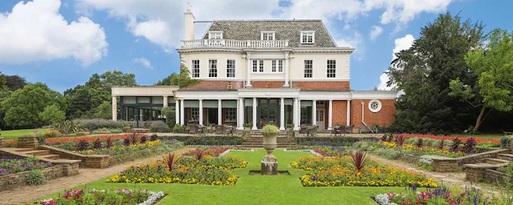 South of the park is Cannizaro House, which took its name (misspelled) from the Sicilian Duke of Cannizzaro, who lived here with his Scottish wife from 1817. The house was built in the early 18th century by a London merchant, and the Duke of Wellington was one of its guests. In 1832, the duke left for Milan to join Duchess Visconti, with whom he had fallen in love. The wife consoled herself with music and a young Italian singer, living in the house until 1841. Today, the villa is a country-style hotel, opened in 1987, where guests enjoy perfect tranquility and the classic elegance of another era. Next to the building is a curious Teapot fountain, resembling a large deformed amphora with spouts from which water springs. Cannizaro Park is a magnificent green area, especially beautiful during the tulip blooming period. At number 22, Ridgway is the Wimbledon Museum. It is a small museum, founded in 1916, focusing on local history, narrated through paintings, prints, and newspapers.
South of the park is Cannizaro House, which took its name (misspelled) from the Sicilian Duke of Cannizzaro, who lived here with his Scottish wife from 1817. The house was built in the early 18th century by a London merchant, and the Duke of Wellington was one of its guests. In 1832, the duke left for Milan to join Duchess Visconti, with whom he had fallen in love. The wife consoled herself with music and a young Italian singer, living in the house until 1841. Today, the villa is a country-style hotel, opened in 1987, where guests enjoy perfect tranquility and the classic elegance of another era. Next to the building is a curious Teapot fountain, resembling a large deformed amphora with spouts from which water springs. Cannizaro Park is a magnificent green area, especially beautiful during the tulip blooming period. At number 22, Ridgway is the Wimbledon Museum. It is a small museum, founded in 1916, focusing on local history, narrated through paintings, prints, and newspapers.WIMBLEDON PARK AND COMMON,
UNDERGROUND STATION: WIMBLEDON PARK
 Wimbledon Park, north of the village, hosts a large lake created by constructing a dam that blocked the waters of a stream. There are also sports facilities, but the most beautiful area to explore is Horse Close Wood on the north side, a path winding amidst ash and oak trees.
Wimbledon Park, north of the village, hosts a large lake created by constructing a dam that blocked the waters of a stream. There are also sports facilities, but the most beautiful area to explore is Horse Close Wood on the north side, a path winding amidst ash and oak trees.Wimbledon Common is located west of the village. It's a vast wooded area, in some parts very dense, crisscrossed by numerous paths. It is beautiful to explore, with its extensive ferns and wild grass, quite different from the cultivated grass and the soft green carpet one might be accustomed to. In the center of the park is a mill, which has been a landmark for the inhabitants from the beginning. Today, it's the only one that has survived of the many that once milled flour. It was built in 1817 by a local blacksmith, commissioned by Charles March, and was intended to serve the community. It remained operational until 1864, when it was removed.
The millers here were also tasked with overseeing the duelists who came to face each other in the park... The building was restored in 1871 and converted into housing. Among the tenants was Baden-Powell, the founder of scouting. It was here that he began to write his manual in 1907.
The Windmill Museum – In 1950, the structure, with all its sails in place, was transformed into a fascinating museum. It contains objects related to the history and technology of windmills, as well as items of peasant life, local history, and the history of scouting. In the entrance, there's a gear wheel and many small models. Children can try grinding grain, lifting sacks of flour, and changing the sails. Visitors can climb up to the tower. The museum is run by volunteers.
Near the south edge of the Common, there is the most romantic of pubs with the most romantic of names, Hand in Hand. It is located at number 6, Crooked Billet. It opened in 1870 and occupies two delightful little adjacent cottages. One can eat there, though it is not exactly cheap, and on nice days, one can even sit in the courtyard. Near the pub are the charity houses known as The Cinque Cottages.
THE CLOCK TOWER,
HIGH STREET,
UNDERGROUND STATION: WIMBLEDON PARK
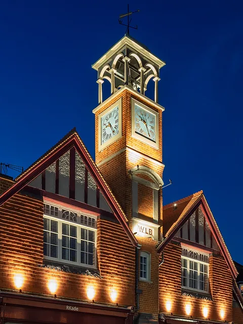 At the end of High Street in Wimbledon Village, atop the Old Fire Station, there's a three-story building that has been converted into a shopping center. It was the old fire station, with three fire engines. It dates back to 1890, when it replaced an older station called May Queen, a small building behind the Dog and Fox, where there is now a stable. In 1900, a major fire broke out at Cannizaro House, and it was discovered that the firefighters did not have a hose long enough to draw water from Rushmere Pond. Consequently, in 1904, it was decided that a new station be built on Queen's Road. Today, the beautiful brick building houses Mothercare. The Clock Tower was restored and significantly modified in 1968.
At the end of High Street in Wimbledon Village, atop the Old Fire Station, there's a three-story building that has been converted into a shopping center. It was the old fire station, with three fire engines. It dates back to 1890, when it replaced an older station called May Queen, a small building behind the Dog and Fox, where there is now a stable. In 1900, a major fire broke out at Cannizaro House, and it was discovered that the firefighters did not have a hose long enough to draw water from Rushmere Pond. Consequently, in 1904, it was decided that a new station be built on Queen's Road. Today, the beautiful brick building houses Mothercare. The Clock Tower was restored and significantly modified in 1968.THE VILLAGE CLUB MUSEUM,
HIGH STREET,
UNDERGROUND STATION: WIMBLEDON
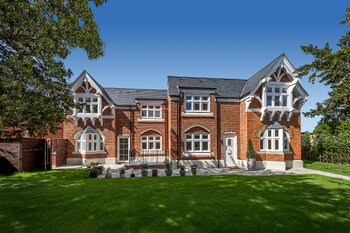 The Village Club hosts the museum of John Evelyn. The diarist and historian had no connection to the village, other than the visits he made to Wimbledon House, but his love for trees and awareness of the importance of preserving the best of the past, in order to benefit the present are most valued. These convictions are important even today, and in this place, they most certainly try to put them into practice.
The Village Club hosts the museum of John Evelyn. The diarist and historian had no connection to the village, other than the visits he made to Wimbledon House, but his love for trees and awareness of the importance of preserving the best of the past, in order to benefit the present are most valued. These convictions are important even today, and in this place, they most certainly try to put them into practice.There are paintings, maps, photographs, and archaeological material, such as Neolithic flint tools and work utensils. There's a herbarium of local plants, a collection of natural history materials, and also documents proving the ownership rights of Nelson's estate in Merton.
The nearby Ridgway, which corners with High Street and runs southwest, is a modern street that follows the path of a pre-Roman trail.
THE TENNIS MUSEUM,
ALL ENGLAND LAWN TENNIS CLUB,
UNDERGROUND STATION: WIMBLEDON
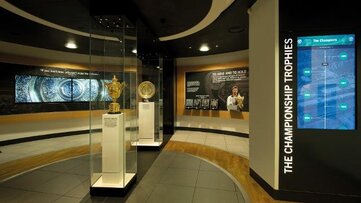 The site where the club, which opened its doors in 1922, now stands, was once the dairy farm of Earl Spencer. The Wimbledon Lawn Tennis Museum is the largest tennis museum in the world. The collection begins dating back to 1955, but there are also older items. There is an observation deck that gives one the distinct feeling of being at Centre Court.
The site where the club, which opened its doors in 1922, now stands, was once the dairy farm of Earl Spencer. The Wimbledon Lawn Tennis Museum is the largest tennis museum in the world. The collection begins dating back to 1955, but there are also older items. There is an observation deck that gives one the distinct feeling of being at Centre Court.The museum houses around fifteen thousand items that recount the history of tennis, including trophies from many years of competitions. There is a screen upon which past matches are projected and even a reconstruction of an 80s locker room from John McEnroe era. His hologram, recreated with technological features, serves as a guide for visitors. For those looking to take home a souvenir, there is a well-stocked shop. There's also a small museum on Church Road, open daily, dedicated to tennis, its history, and its most famous figures.
THE WELL HOUSE,
ARTHUR ROAD,
UNDERGROUND STATION: WIMBLEDON
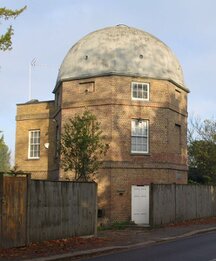 From the church, continuing along the wooden fence on Arthur Road, one encounters a curious octagonal building topped with a blackened dome. In 1975, it was converted into a small dwelling, but originally, it was built to cover a very deep artesian well.
From the church, continuing along the wooden fence on Arthur Road, one encounters a curious octagonal building topped with a blackened dome. In 1975, it was converted into a small dwelling, but originally, it was built to cover a very deep artesian well.The well was dug in 1798 by the first Earl Spencer, ancestor of Lady Diana, to supply water to his country residence: a mechanism pumped it to a tank under the dome.
The well was used until 1815, then it dried up. Surrounding it are Victorian and Edwardian style houses.
THE BUDDHAPADIPA BUDDHIST TEMPLE,
14 CALONNE ROAD,
UNDERGROUND STATION: WIMBLEDON
 It was the first Buddhist temple in the United Kingdom.
It was the first Buddhist temple in the United Kingdom.It is Thai, highly decorated and colorful. Located at the top of a hill, to reach it, one must first walk through a beautiful avenue, then ascend a staircase.
It is open on weekends, and everyone is welcome, including those who are neither Buddhist nor religious.
As soon as one passes the entrance gate, it feels as if one were somewhere in Asia, with monks walking around the surrounding garden.
